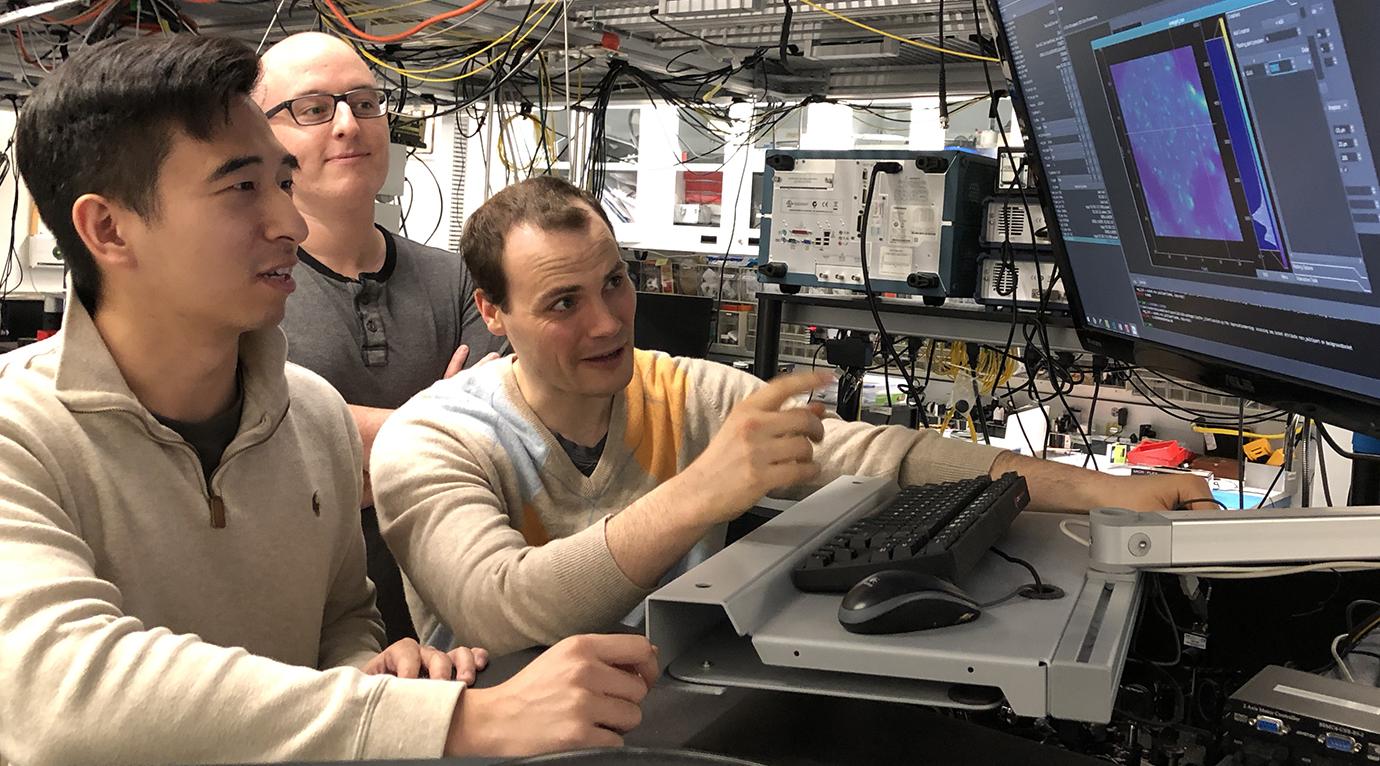
Photo by David Awschalom
After decades of miniaturization, the electronic components we’ve relied on for computers and modern technologies are now starting to reach fundamental limits. Faced with this challenge, engineers and scientists around the world are turning toward a radically new paradigm: quantum information technologies.
Quantum technology, which harnesses the strange rules that govern particles at the atomic level, is normally thought of as much too delicate to coexist with the electronics we use every day in phones, laptops and cars. However, scientists with the University of Chicago’s Pritzker School of Molecular Engineering announced a significant breakthrough: Quantum states can be integrated and controlled in commonly used electronic devices made from silicon carbide.
“The ability to create and control high-performance quantum bits in commercial electronics was a surprise,” said lead investigator David Awschalom, the Liew Family Professor in Molecular Engineering at UChicago and a pioneer in quantum technology. “These discoveries have changed the way we think about developing quantum technologies—perhaps we can find a way to use today’s electronics to build quantum devices.”
In two papers published in Science and Science Advances, Awschalom’s group demonstrated they could electrically control quantum states embedded in silicon carbide. The breakthrough could offer a means to more easily design and build quantum electronics—in contrast to using exotic materials scientists usually need to use for quantum experiments, such as superconducting metals, levitated atoms or diamonds.
These quantum states in silicon carbide have the added benefit of emitting single particles of light with a wavelength near the telecommunications band. “This makes them well suited to long-distance transmission through the same fiber-optic network that already transports 90% of all international data worldwide,” said Awschalom, senior scientist at Argonne National Laboratory and director of the Chicago Quantum Exchange.
Moreover, these light particles can gain exciting new properties when combined with existing electronics. For example, in the Science Advances paper, the team was able to create what Awschalom called a “quantum FM radio;” in the same way music is transmitted to your car radio, quantum information can be sent over extremely long distances.
“All the theory suggests that in order to achieve good quantum control in a material, it should be pure and free of fluctuating fields,” said graduate student Kevin Miao, first author on the paper. “Our results suggest that with proper design, a device can not only mitigate those impurities, but also create additional forms of control that previously were not possible.”
“This work brings us one step closer to the realization of systems capable of storing and distributing quantum information across the world’s fiber-optic networks.”
In the Science paper, they describe a second breakthrough that addresses a very common problem in quantum technology: noise.
“Impurities are common in all semiconductor devices, and at the quantum level, these impurities can scramble the quantum information by creating a noisy electrical environment,” said graduate student Chris Anderson, a co-first author on the paper. “This is a near-universal problem for quantum technologies.”
But, by using one of the basic elements of electronics—the diode, a one-way switch for electrons—the team discovered another unexpected result: The quantum signal suddenly became free of noise and was almost perfectly stable.
“In our experiments we need to use lasers, which unfortunately jostle the electrons around. It’s like a game of musical chairs with electrons; when the light goes out everything stops, but in a different configuration,” said graduate student Alexandre Bourassa, the other co-first author on the paper. “The problem is that this random configuration of electrons affects our quantum state. But we found that applying electric fields removes the electrons from the system and makes it much more stable.”
By integrating the strange physics of quantum mechanics with well-developed classical semiconductor technology, Awschalom and his group are paving the way for the coming quantum technology revolution.
“This work brings us one step closer to the realization of systems capable of storing and distributing quantum information across the world’s fiber-optic networks,” Awschalom said. “Such quantum networks would bring about a novel class of technologies allowing for the creation of unhackable communication channels, the teleportation of single electron states and the realization of a quantum internet.”
Learn more: In surprise breakthrough, scientists create quantum states in everyday electronics
Go deeper with Bing News on:
Quantum information technologies
- Lead-vacancy centers in diamond as building blocks for large-scale quantum networks
A lead-vacancy (PbV) center in diamond has been developed as a quantum emitter for large-scale quantum networks by researchers. This innovative color center exhibits a sharp zero-phonon-line and emits ...
- PSiQuantum to build first utility-scale quantum computer in Australia
The Australian government has invested US$620 million in startup PSiQuantum to build a fault-tolerant quantum system for commercial use.
- NSF pitches Congress on the potential of quantum technology
The National Science Foundation made a case for robust congressional funding in emerging tech research following budget cuts to the agency this year.
- Defence Policy Update Focuses On Quantum Technology's Role In Making Canada Safe
The recent release of the Department of National Defence's policy update, Our North, Strong and Free , outlines the progress being made by the feder ...
- The U.S. Must Win the Quantum Computing Race. History Shows How to Do It
But breakthroughs in 2023 signaled that quantum computers have embarked on a new era, one that may unleash a technological revolution full of possibilities—some good and some bad. On the positive side ...
Go deeper with Google Headlines on:
Quantum information technologies
[google_news title=”” keyword=”quantum information technologies” num_posts=”5″ blurb_length=”0″ show_thumb=”left”]
Go deeper with Bing News on:
Quantum devices
- Keysight Introduces post-quantum cryptography testing capabilities
Keysight Technologies has announced an automated solution designed to test the robustness of post-quantum cryptography (PQC).
- PSiQuantum to build first utility-scale quantum computer in Australia
The Australian government has invested US$620 million in startup PSiQuantum to build a fault-tolerant quantum system for commercial use.
- Australia just made a billion-dollar bet on building the world's first 'useful' quantum computer
The Australian government has announced a pledge of approximately A$940 million (US$617 million) to PsiQuantum, a quantum computing start-up company based in Silicon Valley.
- Mind-Bending Math Could Stop Quantum Hackers—but Few Understand It
This is not a science fiction scenario. It may well become a reality when sufficiently powerful quantum computers come online. These devices will use the strange properties of the quantum world to ...
- Arqit announces collaboration to deliver out-of-the-box post-quantum cryptography solutions
LONDON, April 29, 2024 (GLOBE NEWSWIRE) -- Arqit Quantum Inc. (Nasdaq: ARQQ, ARQQW) (Arqit), a leader in quantum-safe encryption, today announced the creation of the World’s First Quantum-Safe, 1.89 ...
Go deeper with Google Headlines on:
Quantum devices
[google_news title=”” keyword=”quantum devices” num_posts=”5″ blurb_length=”0″ show_thumb=”left”]











